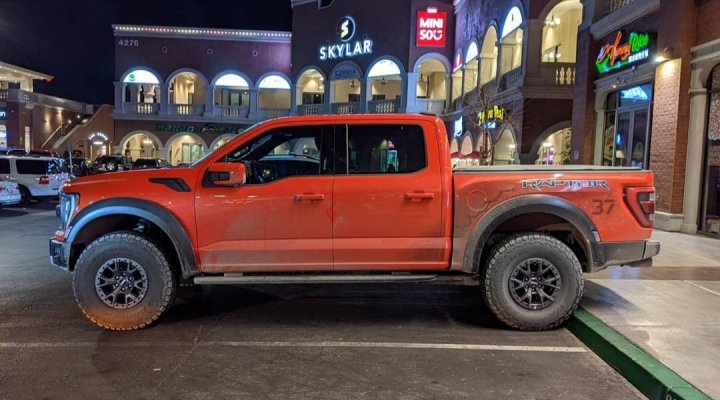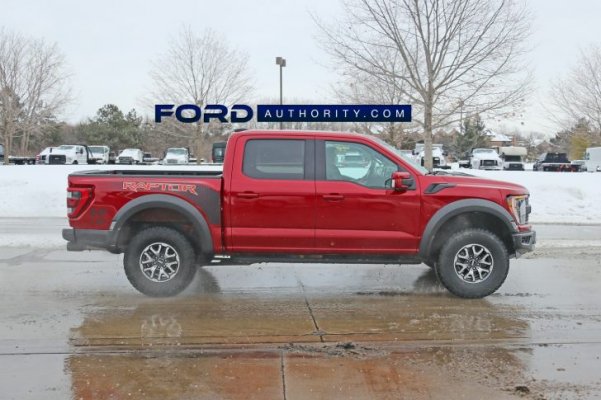You are using an out of date browser. It may not display this or other websites correctly.
You should upgrade or use an alternative browser.
You should upgrade or use an alternative browser.
Fun Calculations on Tire Choices
- Thread starter fts
- Start date
Disclaimer: Links on this page pointing to Amazon, eBay and other sites may include affiliate code. If you click them and make a purchase, we may earn a small commission.
Vintage
Full Access Member
- Joined
- Apr 28, 2018
- Posts
- 348
- Reaction score
- 462
I ordered the 37 Performance Package. Personally I like the look of the 37's better, but that's just my humble opinion.Ordered 35's mainly due to this and the 35's actually look better than the 37's in my opinion, not to mention the significant increase in travel.
Different strokes for different folks or in this case different tire sizes for different folks. Hat's off to Ford for giving us the two options.


Last edited:
melvimbe
FRF Addict
I ordered the 37 Performance Package. Personally I like the look of the 37's better, but that's just my humble opinion.
Different strokes for different folks or in this case different wheel sizes for different folks. Hat's off to Ford for giving us the two options.
Different tire size. 17" wheels with either tire.
Vintage
Full Access Member
- Joined
- Apr 28, 2018
- Posts
- 348
- Reaction score
- 462
melvimbe
FRF Addict
Sorry meant tire size, my bad.
Yep, I know. I just felt like nitpicking and being annoying.

franky16
Full Access Member
The 37s do look good but down in my neck of the woods those ko2s literally just fall apart. Put an open country rt, mt, ridge grappler etc all of the sudden your 10 plus pounds a tire more rotational mass plus ko2s are undersized to begin with
You are correct. I was just having fun with the calculations, not real engineering. I had the formula in memory and wanted to just roughly approximate it to come up with percentage impactThe other is that the equation your using is for centripetal force. Basically, the inward force (from tire edge to center of wheel) needed to keep an object traveling in a circle. (object in motion due to inertia). For example, it's the gravitational force needed to keep a satellite in orbit. Maybe the same formula applies here, and I just don't understand, but it does not seem right. For one thing, I would expected that you would need to take into account rolling resistance and other forces in a calculation of this type?
When it comes to braking, wouldn't the mass of vehicle be a much bigger factor than just the mass of the wheel/tire?
The mass of the vehicle is important of course, but when considering the impact of tire sizes, I am assuming all other variables are the same.
The mass of the vehicle is important, but not a variable for calculating tire size impact.Most of the braking goes toward slowing that 6000lb mass of steel and aluminum, not toward slowing tire rotation. I'd be surprised if braking distance increased so much.
Edit to add: Assuming that the brakes are capable of locking up the wheels.
I don't agree with the assumption related to locking up the wheels. You can lock up the wheels even at 20 mph if jab them, that is not an indicator of the power of the brakes.
Interesting. This is based on the 'new' 37" tires BFG lists on their site, I do not know what is being used on the '21 Raptor. If the difference is only 1 lbs, there should not be any noticeable impact on any part of the performance.According to BFG’s official site the C load 315/70r17 weighs 63.67 lbs per tire and the new C load 37x12.5r17 weighs 64.84 lbs per tire. 1.17 lbs extra per tire.
As a side note, here is an actual test of tire size impact:
I also prefer the look and stance of the vehicle with the 37" frankly. Even with 37s, the truck would still fit into the garage leaving 1" room in door height and 2.5" in length, that's plenty hahaha.
Well, we do agree on something.I was just having fun with the calculations, not real engineering.
melvimbe
FRF Addict
The mass of the vehicle is important of course, but when considering the impact of tire sizes, I am assuming all other variables are the same.
I get the mass is a constant, but I don't think you can assume that the effect of mass on braking is completely independent of tire size. Can you? If that were the case then 35 vs 37 tires on a go-cart would have the same impact as they would on a Raptor (in terms of % change in stopping distance). And that's an extreme example, but I would think a 4k vs 6k lb vehicle would change how the tire size impacts. Maybe it does, don't know, but it's seems like you would need to look at it as interactive system rather than individual parts.
Not completely. Imagine a Raptor on bicycle tires. With the small contact patch it would take half of forever to stop because they would skid so easily. Now imagine a Raptor on slicks from a dragster. You could freaking stop on a dime. Bigger tires and a bigger contact patch should mean a shorter stopping distance, not a longer one. Looking at braking as the inverse of acceleration is an error unless you can spin the wheels at any speed. In which case bigger wheels would mean faster acceleration. That's the reason that top fuel dragsters don't use tiny little wheels in the back ... it's a mistake to use math before you understand the problem. It just confuses things.I get the mass is a constant, but I don't think you can assume that the effect of mass on braking is completely independent of tire size. Can you?
Similar threads
- Replies
- 25
- Views
- 4K
- Replies
- 68
- Views
- 6K
- Replies
- 48
- Views
- 6K
- Replies
- 71
- Views
- 11K
- Replies
- 22
- Views
- 4K
Staff online
-
Big BlueAdministrator
Members online
- alibo70
- Marlboroman
- Solidred
- raptorCAT06
- Booth9999
- Dbone
- crookedAVI
- Sharpie69
- Skai
- GreenGoblin
- Dave__P
- WA2012
- Roscoe S
- Syberspace
- Jay_P
- Raptor513
- dvm
- bolands
- RAPTORSCHIM
- 4x4TruckLEDs.com
- Slaptor911
- sukid
- jond
- Irregular F150
- MurderedOutSVT
- Spike Spiegel
- WP13
- sombra
- someday
- Tomkirkland4
- Dr JL
- Adrenlin
- Big Blue
- Johnny149
- Waterfowler41
- FRAPCNO
- The Car Stereo Company
- pirates1456
- BoostCreep
- Tyler_GTS
- khcollins_43
- Frofan
- Kyle@Apollo-Optics
- raptor_tecate
- DaveInMn
- derekfertig
- AfterMidnightRambler
- RebelSaint
- Hemmy
- soccerUber
Total: 2,072 (members: 92, guests: 1,980)



